Sometimes, the urge to garden might be quelled by other circumstances, such as living arrangements or space constrictions. If you live in an apartment, you can’t really operate a full garden, just because you don’t really have a yard! One of the best solutions for this problem is to grow plants in containers. You can hang these, or just arrange them on your patio, window sill or balcony. Just a few baskets or pots, and your whole living area will look much classier and nicer.
A benefit of growing in small containers is the fact that you can move them around to suit your needs. If you rearrange your furniture and you think that the plants would look nicer in another area, it’s no trouble at all to scoot them over. As long as the lighting is about the same, your plants shouldn’t mind the transition at all. Another benefit of the containers’ versatility is the fact that you can adapt it to simulate any environment depending on the type of soil you fill it with and where you place it.
 Image via Wikipedia
Image via WikipediaIf you are trying to make an aesthetically pleasing arrangement of containers and plants, you can adjust the containers to be at different heights by hanging them from the ceiling or placing them on supports. Hanging them will allow you to make the most of the space you have. This is called “vertical gardening”. If you pull it off right, you can make a very pleasing arrangement of plants while conserving your valuable space.
If you live in an apartment, you know how important it is to conserve space! One method of vertical gardening is the use of a wooden step ladder. If painted correctly, you can arrange all the plants on it in a beautiful, stylish cascade of color.
The maintenance of container plants takes slightly more time, since you have to water more often and go around to each individual container. However, the square footage for container plants is much less than that of an actual garden, so the time spent on maintenance and watering is more balanced. It is important that you don’t over-water your container plants, as this can be just as fatal to their health as under-watering.
When choosing containers for your plants, you’ll want to buy them all at once along with some extras in case they break or you add more plants later. You don’t want them to be all the same shape and size, but definitely the same style so that the compliment each other. Plastic containers are the best and require the least amount of watering, but if you want to stick with clay or earthen pots then you should line the inside with plastic. This helps it retain water more, as the clay will soak up water. (Just make sure if you do this, that you poke some holes in the bottom so that excess water doesn’t sit and drown the roots of your plants!)
 Image by LollyKnit via Flickr
Image by LollyKnit via FlickrAnother thing to remember when buying pots is the fact that the size of the pot will ultimately constrict the size of the plant. Make a careful choice of pots according to what you wish to grow in each one. If you search for the plant you chose on the internet, you should be able to find specifications as to how much root space it should be given. This can even be an advantage for you if you choose a plant that can grow very large. If you only have a limited amount of space for it, you can constrict it by choosing a pot that isn’t large enough to support huge amounts of growth, and this will keep the plant smaller
If the benefits of container gardening sound appealing to you, you can start planning out your container garden today. If you write a list of all the plants you desire to have, you can do the necessary research to find out what size and shape of pots you should get. After that, it’s just a matter of arranging them in a way that makes your home look the nicest.
 available on the market today, with just a little assembly required.
available on the market today, with just a little assembly required.















